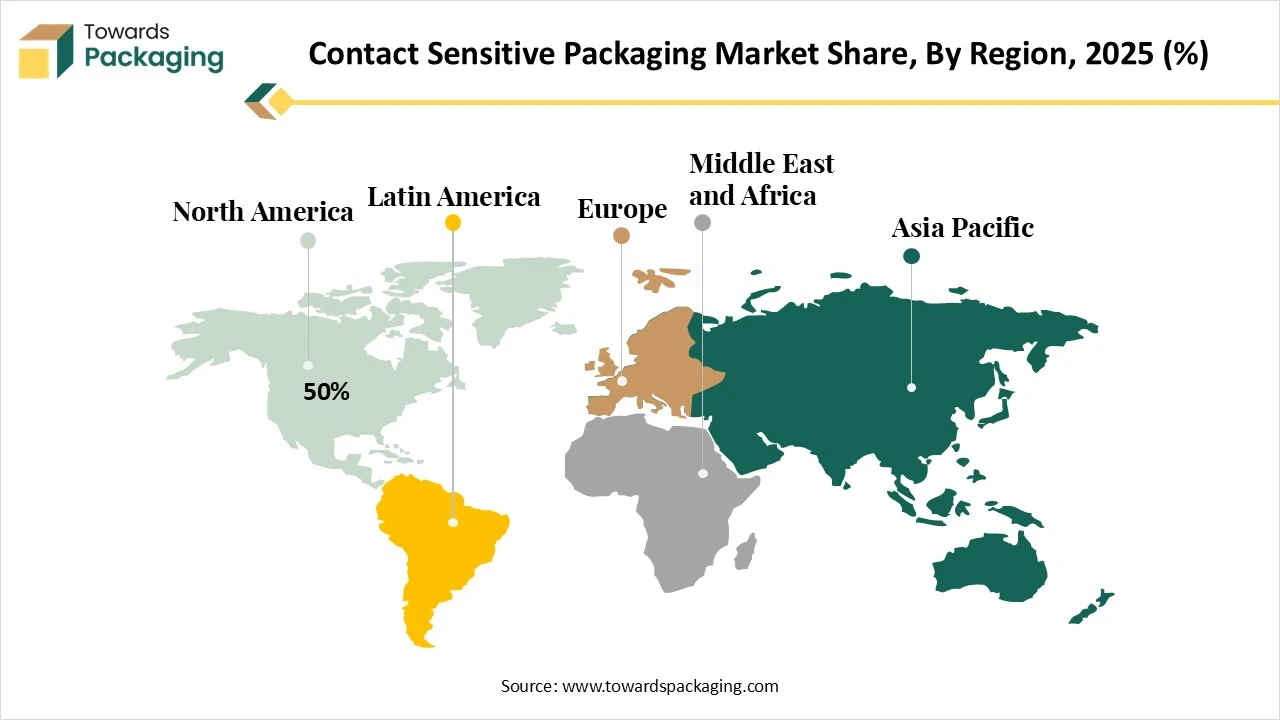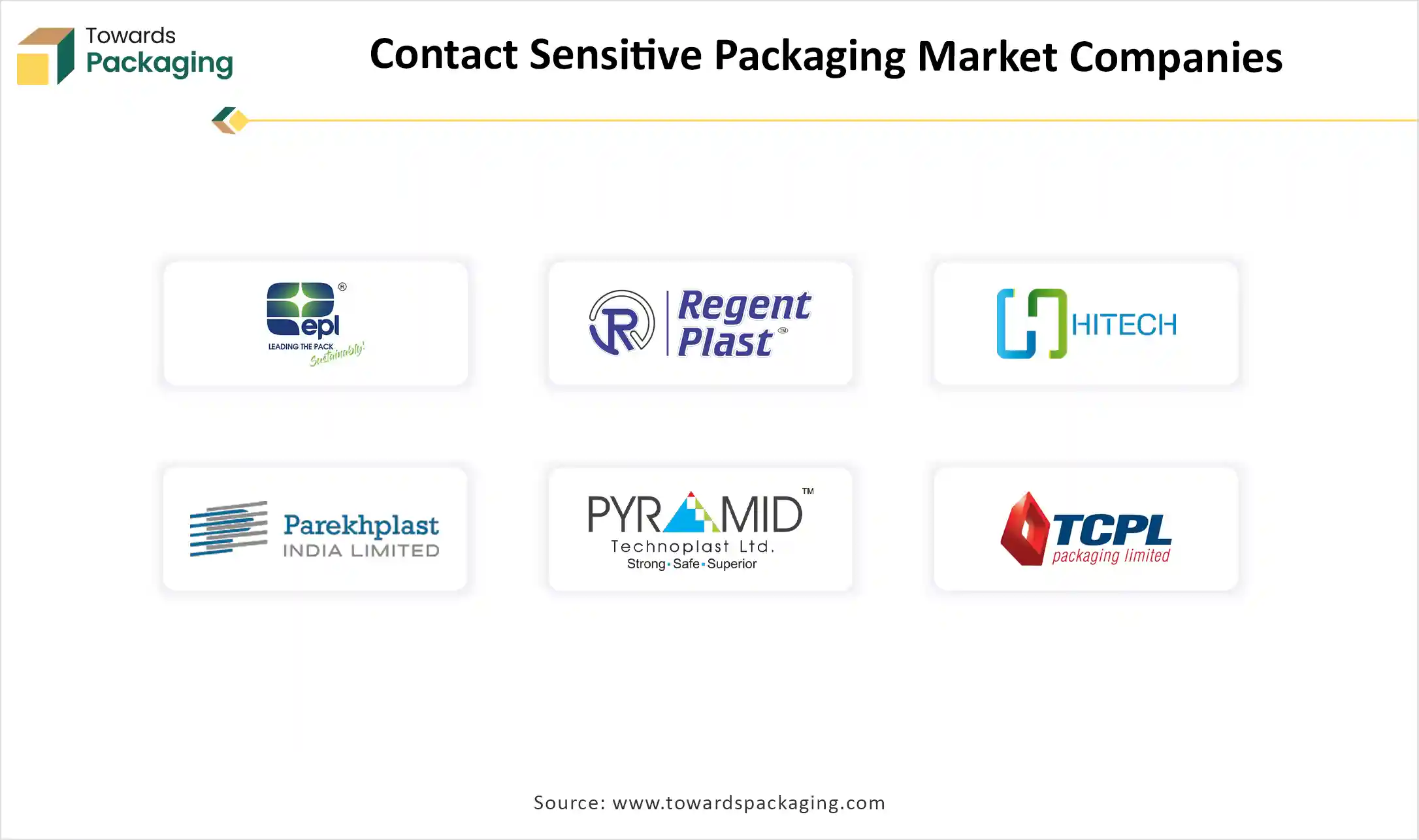The contact sensitive packaging market provides complete coverage of global revenue size, multi-year growth outlook, and segment-wise performance across packaging type, material and end-use industry. The report includes statistical insights on regional markets including North America’s 2024 dominance, Europe’s regulatory-driven transformation, Asia Pacific’s fastest CAGR outlook from 2025 to 2034, and emerging opportunities in Latin America and MEA.
It presents detailed value chain mapping, import–export trade data, raw material sourcing patterns, manufacturing footprints, key suppliers, and competitive analysis of leading companies operating in pressure-sensitive labels, aluminum foil packaging, and advanced films such as PET and BOPP.
Contact sensitive packaging is the plastic packaging for goods within the space of some other specified EU supplies, comprising resources and articles planned to come into contact with medical equipment, food, cosmetic products, veterinary medicinal substances, therapeutic goods, and dangerous products. The recycled content requirements do not apply to packaging that is in direct connection with medicinal goods, some contact-sensitive plastic packaging, decomposable plastic packaging, and packing utilized for the transportation of dangerous products.
The growing demand for supply chain tracking facilities, interactive customer experiences, and anti-counterfeiting has raised the development of packaging with near-field communication.
The rising inclination towards materials that are sustainable eliminates traditional release and raises innovation in the contact-sensitive packaging industry.
The rising demand for customization and digital printing is due to the intention to produce unique packaging for products.
| Metric | Details |
| Growth Drivers | - Rapid e-commerce expansion - Healthcare and pharmaceutical innovation - Smart labeling and tracking |
| Leading Region | North America |
| Market Segmentation | By Packaging Type, By Material, By End-Use Industry and By Region Covered |
| Top Key Players | EPL Limited, Regent Plast Pvt. Ltd, Hitech Corporation, Parekhplast India Limited, Pyramid Technoplast Pvt. Ltd |
In contact contact-sensitive packaging sector, AI plays a significant role in improving the quality of the packaging and certifying the protection of the healthcare & pharmaceutical goods. It takes information from the implanted sensor to track quality or product security in real time. Machine learning is widely utilized to predict the shelf-life of the product and ensure a longer storage period by maintaining the integrity of the product. It automates the repetitive process, which increases the production of high-quality packaging and controls the quality by reducing human error. AI is widely used for the customization of the packaging to generate unique designs. By analysing the market demand, it reduces the wastage of the products by reducing over overproduction process. Artificial intelligence is extensively incorporated to improve the quality of packaging in several ways.
Growing Industrial Demand
The huge industrial demand due to continuous innovation in the healthcare and pharmaceutical sectors has raised the demand for the contact-sensitive packaging market. The massive growth in the trend for online shopping has raised the demand to develop packaging with advancements such as tracking technology and several other features. The robust guidelines in the packaging of healthcare products have also enhanced such packaging integration with smart labels, temperature-sensitive, and tamper-evident tapes. There is a huge upsurge among consumers regarding eco-friendly packaging of products that are recyclable, compostable, and bioadhesive.
Restricted Adoption, Profitability, and Scalability
This smart contact-sensitive packaging is highly charge due to the high-quality materials utilization and incorporation of advanced technology. This type of packaging is high in cost in comparison to traditional packaging, which limits the expansion of. A rising economy sometimes reduces access to smart labelling technology or sustainable resources.
Regulatory Evolution and Innovation
The wide acceptance of packaging with RFID, QR codes, and NFC facilities has raised the potential of the contact-sensitive packaging market and widened several opportunities for the development of this sector. The growing demand for customization in packages with personalized labels, digital printing, and regionalized packaging has influenced the major market players to introduce innovations in the market that meet the demand of the consumers.
The pressure-sensitive labels segment is expected to have a considerable share of the contact-sensitive packaging market in 2024 due to its versatility, high-speed application, and exclusive print quality. This segment contains a huge range of materials, such as curved containers, plastic, metal, glass, and cardboard, as these materials do not require any heat or solvents. These are considered suitable for maintaining high-speed labelling mainly in rapidly growing beverages, e-commerce, and retail sectors.
The cold-form blister packaging segment is expected to grow at the fastest rate in the market during the forecast period of 2025 to 2034. This type of packaging is considered high-barrier and unit-dose packaging, which is mainly utilized in the pharmaceutical industry. These are the laminated aluminum packaging assemblies manufactured without applying heat to them. These offer high moisture resistance, light, and oxygen resistance.
The foil (Aluminum) segment dominated the contact sensitive packaging market in 2024 due to the high-quality protection properties from bacteria, moisture, light, and oxygen. This type of packaging is mainly used in the pharmaceutical sector and the food & beverage industry. The heat-sealable lids are used for the storage of dairy, beverages, and ready-to-eat meals. The aluminum foils work as the lidding film for plastic containers and trays to maintain hygiene and ensure the safety of the products.
The Fflm (Plastic, BOPP, PET) segment is expected to grow at the fastest rate in the market during the forecast period of 2025 to 2034. These materials are extensively utilized because of their durability and high flexibility, which provide excellent moisture resistance and printability. Several industries, such as food, retail, pharma, logistics, cosmetics, and electronics, have adopted this material for the packaging of products.
The food & beverage segment is expected to have a considerable share of the contact sensitive packaging market in 2024 due to the growing requirement for wrapping, labelling, and sealing. In the food & beverages industry, the custom printing facility and label aesthetics play an important role. The constant demand for traceability, large shelf life, and nutritional labels has influenced the development of this packaging market.
The healthcare & pharmaceuticals segment is expected to grow at the fastest rate in the market during the forecast period of 2025 to 2034. The strict guidelines for the healthcare packaging sector have raised the demand for contact-sensitive packaging of the products. Pharma products packaging requires temperature and pressure-sensitive packaging to maintain the integrity of the products.

The North America region held the largest share of the contact-sensitive packaging market in 2024, due to the presence of advanced facilities for healthcare and the growing pharmaceutical industry. The presence of a huge number of aged populations caused higher cases of chronic diseases, which require enhanced quality treatment and medication that boosts this market to develop rapidly.
The rapid advancement in the technological sector of the contact-sensitive packaging market has raised the demand for pressure-sensitive packaging of products. The huge presence of e-commerce platforms such as Walmart and Amazon has boosted the growth of the market. Supervisory pressure has also pushed for the adoption of sustainable packaging in a wide range of industries.
The strict supervisory guidelines have influenced the demand for pressure-sensitive labelling on the products to inform about all the details of the product. Rising sustainable and organic packaging has raised the inclination of the brands towards contact-sensitive packaging of the products.
The Asia Pacific region is estimated to grow at the fastest rate in the contact-sensitive packaging market during the forecast period. The continuous collaboration between major market players for research and development has influenced the growth of this industry. In countries such as India, China, Japan, South Korea, and several others, there is a huge upsurge in online ordering, which requires enhanced packaging with detailed information as well as tracking facilities.

By Packaging Type
By Material
By End-Use Industry
By Region Covered
January 2026
December 2025
December 2025
December 2025